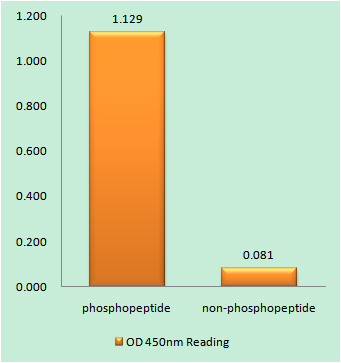
Catalog: KA1637C
Size
Price
Status
Qty.
96well
$470.00
In stock
0
Add to cart


Collected


Collect
Main Information
Target
PDPK1 Phospho Ser241
Reactivity
Human, Mouse, Rat
Applications
ELISA
Conjugate/Modification
Phospho
Detailed Information
Storage
2-8°C/6 months,Ship by ice bag
Modification
Phospho
Detection Method
Colorimetric
Related Products
Antigen&Target Information
Gene Name:
PDPK1
show all
Other Name:
3-phosphoinositide-dependent protein kinase 1 ;
hPDK1 ;
hPDK1 ;
show all
Background:
catalytic activity:ATP + a protein = ADP + a phosphoprotein.,function:Phosphorylates and activates not only PKB/AKT, but also PKA, PKC-zeta, RPS6KA1 and RPS6KB1. May play a general role in signaling processes and in development (By similarity). Isoform 3 is catalytically inactive.,PTM:Phosphorylated on tyrosine and serine/threonine. Phosphorylation on Ser-241 in the activation loop is required for full activity. PDK1 itself can autophosphorylate Ser-241, leading to its own activation.,similarity:Belongs to the protein kinase superfamily.,similarity:Belongs to the protein kinase superfamily. AGC Ser/Thr protein kinase family. PDK1 subfamily.,similarity:Contains 1 PH domain.,similarity:Contains 1 protein kinase domain.,subcellular location:Membrane-associated after cell stimulation leading to its translocation. Tyrosine phosphorylation seems to occur only at the plasma membrane.,subunit:Interacts with TUSC4.,tissue specificity:Appears to be expressed ubiquitously.,
show all
Function:
protein amino acid phosphorylation, negative regulation of protein kinase activity, phosphorus metabolic process,phosphate metabolic process, response to osmotic stress, hyperosmotic response, cytoskeleton organization, cell-substrate junction assembly, cell adhesion, cell-matrix adhesion, intracellular signaling cascade, response to abiotic stimulus, response to endogenous stimulus, response to hormone stimulus, response to organic substance,phosphorylation, peptidyl-threonine phosphorylation, peptidyl-threonine modification, regulation of phosphate metabolic process, biological adhesion, actin filament-based process, actin cytoskeleton organization, cell-substrate adhesion, activation of protein kinase activity, activation of protein kinase B activity, response to insulin stimulus,cellular response to insulin stimulus, cellular response to hormone stimulus, regulation of protein localization, negative regulation of kinase activity, positive regulation of kinase activity, cell junction assembly, cell junction organization,regulation of phosphorylation, positive regulation of catalytic activity, negative regulation of catalytic activity, response to peptide hormone stimulus, regulation of kinase activity, negative regulation of molecular function, positive regulation of molecular function, regulation of protein kinase activity, positive regulation of protein kinase activity, focal adhesion formation, positive regulation of cellular component organization, regulation of phosphorus metabolic process, regulation of transferase activity, positive regulation of transferase activity, negative regulation of transferase activity, regulation of establishment of protein localization, regulation of establishment of protein localization to plasma membrane, positive regulation of establishment of protein localization to plasma membrane,
show all
Cellular Localization:
Cytoplasm. Nucleus. Cell membrane; Peripheral membrane protein. Cell junction, focal adhesion. Tyrosine phosphorylation seems to occur only at the cell membrane. Translocates to the cell membrane following insulin stimulation by a mechanism that involves binding to GRB14 and INSR. SRC and HSP90 promote its localization to the cell membrane. Its nuclear localization is dependent on its association with PTPN6 and its phosphorylation at Ser-396. Restricted to the nucleus in neuronal cells while in non-neuronal cells it is found in the cytoplasm. The Ser-241 phosphorylated form is distributed along the perinuclear region in neuronal cells while in non-neuronal cells it is found in both the nucleus and the cytoplasm. IGF1 transiently increases phosphorylation at Ser-241 of neuronal PDPK1, resulting in its translocation to other cellular compartments. The tyrosine-phosphorylated form colocalizes with PTK2B in focal adhesions after angiotensin II stimulation.
show all
Signaling Pathway
Cellular Processes >> Transport and catabolism >> Autophagy - animal
Cellular Processes >> Cell growth and death >> Apoptosis
Cellular Processes >> Cellular community - eukaryotes >> Focal adhesion
Organismal Systems >> Immune system >> T cell receptor signaling pathway
Organismal Systems >> Immune system >> Fc epsilon RI signaling pathway
Organismal Systems >> Endocrine system >> Insulin signaling pathway
Organismal Systems >> Endocrine system >> PPAR signaling pathway
Organismal Systems >> Endocrine system >> Thyroid hormone signaling pathway
Organismal Systems >> Nervous system >> Neurotrophin signaling pathway
Human Diseases >> Cancer: specific types >> Prostate cancer
Human Diseases >> Cancer: specific types >> Endometrial cancer
Human Diseases >> Cancer: specific types >> Non-small cell lung cancer
Environmental Information Processing >> Signal transduction >> FoxO signaling pathway
Environmental Information Processing >> Signal transduction >> Sphingolipid signaling pathway
Environmental Information Processing >> Signal transduction >> PI3K-Akt signaling pathway
Environmental Information Processing >> Signal transduction >> AMPK signaling pathway
Environmental Information Processing >> Signal transduction >> mTOR signaling pathway
Reference Citation({{totalcount}})
Catalog: KA1637C
Size
Price
Status
Qty.
96well
$470.00
In stock
0
Add to cart


Collected


Collect
Recently Viewed Products
Clear allPRODUCTS
CUSTOMIZED
ABOUT US
Toggle night Mode
{{pinfoXq.title || ''}}
Catalog: {{pinfoXq.catalog || ''}}
Filter:
All
{{item.name}}
{{pinfo.title}}
-{{pinfo.catalog}}
Main Information
Target
{{pinfo.target}}
Reactivity
{{pinfo.react}}
Applications
{{pinfo.applicat}}
Conjugate/Modification
{{pinfo.coupling}}/{{pinfo.modific}}
MW (kDa)
{{pinfo.mwcalc}}
Host Species
{{pinfo.hostspec}}
Isotype
{{pinfo.isotype}}
Product {{index}}/{{pcount}}
Prev
Next
{{pvTitle}}
Scroll wheel zooms the picture
{{pvDescr}}

















